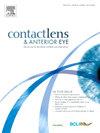Interocular astigmatic symmetry: A systematic review
IF 4.1
3区 医学
Q1 OPHTHALMOLOGY
引用次数: 0
Abstract
Purpose
The objective of this investigation was to consolidate the extant data pertaining to interocular astigmatic symmetry, with a view to discerning any patterns that may emerge from the research.
Methods
A systematic literature review was conducted in accordance with the PICO framework. The search, conducted through September 2024, included three databases (PubMed, Web of Science, and Scopus) and the reference list of the selected articles, which were identified from inception. The articles were selected based on the inclusion criteria of population-based studies with data on interocular astigmatic symmetry.
Results
A total of 65 articles were retrieved, of which 13 met the inclusion criteria. The thirteen studies included a total of 329,747 subjects from ten different countries. The prevalence of interocular astigmatic symmetry according to axis orientation was isorule in most of the articles (i.e., both eyes having the same pattern: with-the-rule astigmatism, against-the-rule astigmatism, or oblique astigmatism), except for those pertaining to the geriatric population. Regarding the classification according to axis orientation, mirror symmetry was demonstrated to be the most prevalent pattern in interocular astigmatism. Genetic and individual factors, such as age, sex, and refractive error, did not exhibit a discernible influence on interocular astigmatic symmetry.
Conclusion
The findings of this study indicated a clear trend through the isorule pattern and mirror symmetry in a population.
眼间散光对称性:系统综述。
目的:本研究的目的是巩固有关眼间散光对称性的现有数据,以期从研究中发现任何可能出现的模式。方法:按照PICO框架进行系统的文献综述。检索持续到2024年9月,包括三个数据库(PubMed, Web of Science和Scopus)和选定文章的参考文献列表,这些文章从一开始就被确定。文章的选择是基于基于人群的研究的纳入标准,包括眼间散光对称性的数据。结果:共检索到65篇文献,其中13篇符合纳入标准。这13项研究共包括来自10个不同国家的329747名受试者。除老年人群外,根据轴向的眼间散光对称性在大多数文章中是均匀的(即双眼具有相同的模式:顺条散光、反条散光或斜向散光)。根据轴向分类,镜对称被证明是眼间散光最普遍的模式。遗传和个体因素,如年龄、性别和屈光不正,对眼间散光对称性没有明显的影响。结论:本研究结果表明,通过群体的等规则模式和镜像对称,有明显的趋势。
本文章由计算机程序翻译,如有差异,请以英文原文为准。
求助全文
约1分钟内获得全文
求助全文
来源期刊

Contact Lens & Anterior Eye
OPHTHALMOLOGY-
CiteScore
7.60
自引率
18.80%
发文量
198
审稿时长
55 days
期刊介绍:
Contact Lens & Anterior Eye is a research-based journal covering all aspects of contact lens theory and practice, including original articles on invention and innovations, as well as the regular features of: Case Reports; Literary Reviews; Editorials; Instrumentation and Techniques and Dates of Professional Meetings.
 求助内容:
求助内容: 应助结果提醒方式:
应助结果提醒方式:


